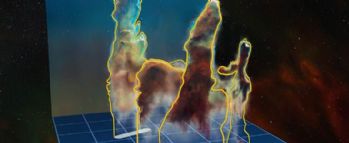
Using the MUSE instrument on ESO's Very Large Telescope (VLT), astronomers have produced the first complete three-dimensional view of the famous Pillars of Creation in the Eagle Nebula, Messier 16. The new observations demonstrate how the different dusty pillars of this iconic object are distributed in space and reveal many new details - including a previously unseen jet from a young star. Intense radiation and stellar winds from the cluster's brilliant stars have sculpted the dusty Pillars of Creation over time and should fully evaporate them in about three million years.
The original NASA/ESA Hubble Space Telescope image of the famous Pillars of Creation was taken two decades ago and immediately became one of its most famous and evocative pictures. Since then, these billowing clouds, which extend over a few light-years, have awed scientists and the public alike.
The jutting structures, along with the nearby star cluster, NGC 6611, are parts of a star formation region called the Eagle Nebula, also known as Messier 16 or M16. The nebula and its associated objects are located about 7000 light-years away in the constellation of Serpens (The Serpent).
The Pillars of Creation are a classic example of the column-like shapes that develop in the giant clouds of gas and dust that are the birthplaces of new stars. The columns arise when immense, freshly formed blue-white O and B stars give off intense ultraviolet radiation and stellar winds that blow away less dense materials from their vicinity.
Denser pockets of gas and dust, however, can resist this erosion for longer. Behind such thicker dust pockets, material is shielded from the harsh, withering glare of O and B stars. This shielding creates dark "tails" or "elephant trunks", which we see as the dusky body of a pillar, that point away from the brilliant stars.
(...)